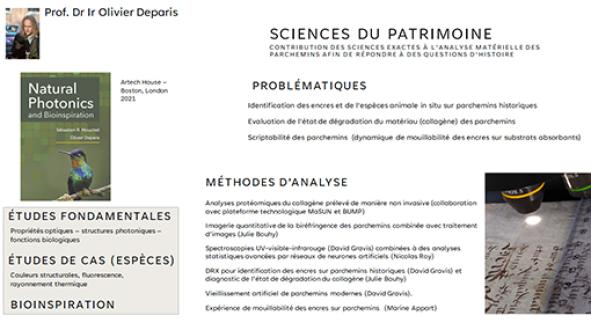We study natural photonic structures, in connection with the evolution of certain biological functions in the living world (e.g. structural coloration). We develop bio-inspired applications in the field of materials and, in particular, devices using solar energy. Finally, we use and develop optical material characterization techniques for heritage sciences, notably in transdisciplinary research on parchments.

Photonic structures present in biological tissues such as butterfly wings, beetle elytra or fish scales are responsible for a wide range of optical effects such as iridescence, narrow-band reflection, solid wide-angle scattering, polarization, additive color mixing, fluid-induced color changes and controlled fluorescence. For more information on our research on this topic, and more generally on global research in natural photonics and bioinspiration, we invite you to read our book published by Artech house in 2021 (ISBN: 9781630817978), or, alternatively, the following popular review of our research activities published by the press entitled "At Unamur, nature reveals its photonic secrets"
Bibliographical resources:
- M. Ladouce et al. "Scattering of ultraviolet light by avian eggshells", Faraday Discussions 223 (2020), 63-80.
- S. R. Mouchet et al. "Nonlinear optical spectroscopy and two photon excited fluorescence spectroscopy reveal the excited states of fluorophores embedded in a beetle's elytra", Interface Focus 9 (2018), 20180052.
We conduct transdisciplinary research on medieval parchment and manuscripts. Our team (Pergamenum21) includes physicists, chemists, biologists, historians and conservators from the University of Namur. We collaborate with other research groups abroad involved in the science of cultural heritage.
For example, we are currently studying the anatomy of limp parchment bindings (limp vellum). The corpus consists of 16th to 17th century limp bindings from the Spanish Netherlands. We also studied parchment manuscripts and charters from Orval Abbey in Belgium. This study sheds new light on the work of a Cistercian scriptorium, thanks to our findings of correlations between the distribution of animal species among parchments and their presumed place of production. Both projects received financial support from the King Baudouin Foundation.
Bibliographical resource:
Light is an ideal probe for analytical studies on ancient manuscripts, as photons interact with parchment non-invasively. We are developing optical methods in our laboratory to characterize manuscripts from different aspects. For example, we have developed a non-invasive quantitative imaging method to measure the spatial distribution of birefringence in parchments.
Bibliographic resource:
Composition of the research team
Promoter (PI) : Olivier Deparis
Olivier Deparis, Director of the LPS, is also affiliated with the PATHs Institutes, naXys and NISM (Research cluster NOP).
Other members
Doctors: Julie Bouhy and Marine Appart
Thesis topics (Pr. Olivier Deparis)
- Finite element numerical study of a planar solar concentrator model
- Development of surface and optical analysis methods for material characterization of heritage objects
- Interdisciplinary study of the interaction of light and thermal radiation with photonic structures resulting from the evolution of biological functions of certain animal or plant species

